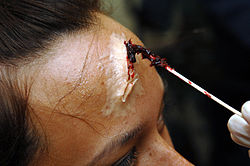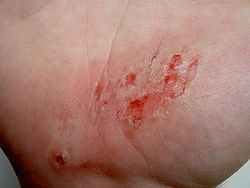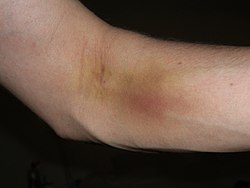Emergency bleeding control
| Emergency bleeding control | |
|---|---|
| Specialty | Emergency medicine |
Emergency bleeding control describes actions that control
Types of wounds
Wounds are normally described in a variety of ways. Descriptions may include wound size (length) and thickness; plainly visible wound characteristics such as shape and open or closed; and origin, acute or chronic.[3] The most common descriptors of wounds are these:
- Incision: Straight edges to the wound margins, as if sliced with a knife. These can vary in size, and may be caused by a variety of objects, including a scalpel, a knife, any piece of straight, sharp metal, or a piece of glass. Tissue is rarely missing from the wound site, and the margins of the wound may be easily matched from one side of the wound to the other for the purposes of closure.[4]
- edge, such as a piece of broken glass or metal, but may also be caused by a blow from a blunt object to tissue with bone immediately behind it.
- internal organs. They may cause substantial internal bleeding or secondary injuries, such as a collapsed lung, which may not be readily evident during primary assessment. Occasionally, the object causing the injury remains in the wound as an impaled object. A stab wound from a knife or other sharp object, or a bullet wound, are examples of this type of injury. Medical professionals usually refer to this type of wound as penetrating trauma.
- capillaries, are affected. This may be the result of a fall, or of sliding (friction) against rough surfaces. The road rash often suffered by falling motorcyclists is an example of this type of wound.
- discoloration. Blood loss is generally limited, and not of serious consequence. It may, however, act as a signpost, pointing to more serious injuries.
- viscera. Avulsions are difficult to repair, and no avulsion should ever be considered a minor injury.
- Amputation: Similar to, but distinct from, an avulsion. Whereas an avulsion is characterized by a "flap" of skin being removed, an amputation is characterized by a complete loss of a limb. This can occur at any point on the extremity, and is usually followed by significant arterial bleeding. However, as serious as this injury is, an amputated limb that is cooled and transported to the hospital can sometimes be surgically reattached.
- Types of wounds
-
Laceration moulage
-
Abrasion on the palm of the hand
-
Contusion
Blood vessels affected
External bleeding is generally described in terms of the origin of the blood flow by vessel type. The basic categories of external
- Arterial bleeding: As the name suggests, blood flow originating in an spurts, rather than in a steady flow; the blood spurts out in time with the heartbeat. The amount of blood loss can be copious, and can occur very rapidly.[10]
- Venous bleeding: This blood is flowing from a damaged vein. As a result, it is blackish in colour (due to the lack of oxygen it transports) and flows in a steady manner. Caution is still indicated: while the blood loss may not be arterial, it can still be quite substantial, and can occur with surprising speed without intervention.[11]
- Capillary bleeding: Capillary bleeding usually occurs in superficial wounds, such as
Wound management
The treatment of wounds depends on whether they are external or internal.
- External wounds bleed outside through a skin break. They need an external wound management (read below).
- Internal wounds bleed inside, but some of them can pour blood outside through a natural hole. They need an internal wound management (read below).
External wound management
The
Main methods of wound management are:[13]
Direct pressure
Direct pressure is the common method. The pressure on the wound constricts the blood vessels manually, helping to stem blood flow. When applying pressure, the type and direction of the wound may have an effect, for instance, a cut lengthways on the hand would be opened up by closing the hand into a fist, whilst a cut across the hand would be sealed by making a fist. A patient can apply pressure directly to their own wound, if their level of consciousness allows.
Ideally, a barrier, such as sterile, low-adherent gauze should be used between the pressure supplier and the wound, to help reduce chances of
Direct pressure can be used with some foreign objects protruding from a wound. Then, padding is applied from each side of the object to push in and seal the wound. The foreign objects are not removed until arriving to a medical center.
Elevation
Elevation was commonly recommended for the control of haemorrhage. Some protocols continue to include it, but recent studies have failed to find any evidence of its effectiveness and it was removed from the
Cold
The cold can add some utility, at least to compress the blood vessels.
Pressure points

In situations where direct pressure and elevation are either not possible or proving ineffective, and there is a risk of
Epistaxis
- tear ducts.[citation needed]
Tourniquet
Another method of achieving constriction of the supplying artery is a
Improvised tourniquets, in addition to creating potential problems for the ongoing medical management of the patient, usually fail to achieve force enough to adequately compress the arteries of the limb. As a result, they not only fail to stop arterial bleeding, but may actually increase bleeding by impairing venous bloodflow.[16]
Clotting agents and medications
Some protocols call for the use of clotting accelerating agents, which can be either externally applied as a powder or gel, or pre-dosed in a dressing or as an
For stopping or preventing bleeding in people who do not have haemophilia, there is weak to little evidence to support the use of clotting factors to prevent death.
A new product of this type (Cresilon Hemostatic Gel or CHG, Vetigel in its veterenary version)[21][22] allows to close great wounds in a few moments.
Internal wound management
Internal wounds (usually to the
An internal bleeding require to call to emergency medical services.
In the event of bleeding caused by an external source (trauma, penetrating wound), the patient is usually inclined to the injured side, so that the 'good' side can continue to function properly, without interference from the blood inside the body cavity.[citation needed]
Use of cold around the damaged area (for example: with ice) can help to compress the blood vessels.
Treatment of internal bleeding is beyond the scope of simple first aid, and a person giving first aid should consider it potentially life-threatening. The definitive treatment for internal bleeding is always surgical treatment, and medical advice must be sought urgently for any victim of internal bleeding.[24]
See also
References
- ^ "Bleeding". MedlinePlus. Retrieved 2007-06-15.
- ^ Cyr, Dawna L; Johnson, Steven B (September 2006). "Basic First Aid". The University of Maine. Archived from the original on 2007-06-10. Retrieved 2007-06-21.
- ^ "NHS Formulary website" (PDF). Archived from the original (PDF) on 2012-03-10. Retrieved 2009-02-03.
- ^ "Surgeryonline website". Retrieved 2009-02-03.
- ^ "Wounds (1) (Merck Manual online)". Retrieved 2009-02-03.
- ^ "Healthypeer website". Retrieved 2020-12-16.
- ^ "Types of Wounds (Hansaplast.com website)". Archived from the original on 2008-12-04. Retrieved 2009-02-03.
- ^ 'Contusion' Merrian-Webster. Retrieved 24/01/2018
- ISBN 0-7637-3016-5.
- ^ "U.S. Navy Standard First Aid Manual, Chapter 3 (online)". Retrieved 2003-02-03.
- ^ Why Having a First Aid Kit is Important?
- ^ "Control Bleeding (SUNY website)". Archived from the original on 2009-01-29. Retrieved 2009-02-03.
- ^ 'Wound Care' The Royal Children's Hospital Melbourne. (2013). (Clinical Guidelines). Retrieved 24/01/2018
- ISBN 978-0323065023.
- ^ "Bleeding (U.S. Navy Standard First Aid Manual online". Retrieved 2009-02-03.
- ^ "New Guidelines (AHA Journal Circulation online)". Archived from the original on 2009-02-02. Retrieved 2009-01-03.
- ^ "MedMarketDiligence website". Retrieved 2008-02-03.
- ^ PMID 30582172.
- ^ PMID 22419303.
- ^ FIRST AID course, 10 March 2023
- ^ "Cresilon". Cresilon. Retrieved 2023-10-12.
- ^ Cresilon (28 June 2023). "Cresilon Receives First FDA Clearance For Human Use of Hemostatic Gel Technology". Cresilon. Retrieved 2023-10-12.
- ^ "Aneurysms (Merck Manual online)". Retrieved 2009-02-03.
- ^ "Internal Bleeding: First Aid (Merck Manual online)". Retrieved 2009-02-03.



